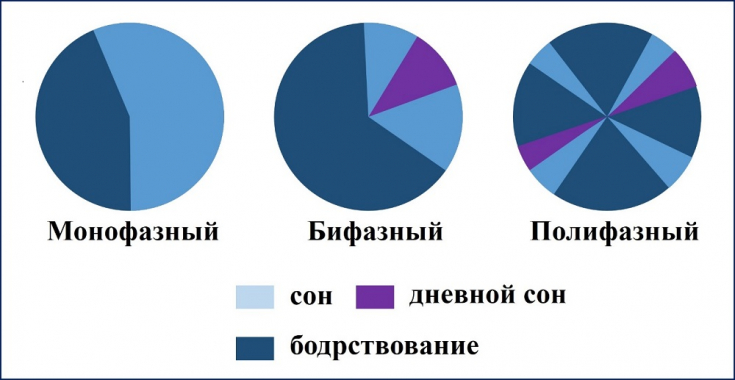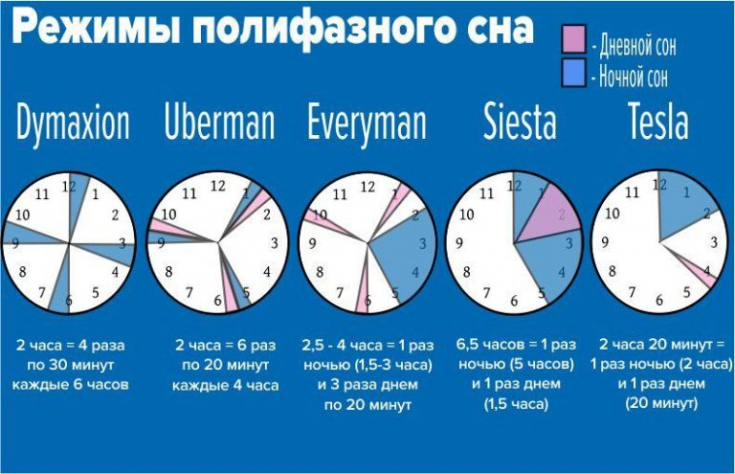Many are sorely lacking hours for sleep , because everywhere you need to be in time. The problem is that such a sleep pattern has a negative effect on well-being, and, consequently, on performance.
At one time, Leonardo da Vinci himself faced such a problem and, due to his resourcefulness, was able to successfully solve it. Find out in this article about polyphasic sleep, also known as “genius sleep.”
- Leonardo da Vinci's secret how to sleep in 1 hour
- The essence of the phenomenon of polyphasic sleep
- Sleep techniques “Dymaxion”, “Uberman” and "Everyman"
Leonardo da Vinci's secret how to sleep in 1 hour
Leonardo da Vinci got out of the situation by breaking the night's sleep into several parts, thus turning it into a polyphasic one. After that, the artist's sleep took 15 minutes, provided that he rested every 4 hours. In this way, it was possible to reduce the total duration of sleep to one and a half hours per day.
Da Vinci had a lot of free time, which he devoted, of course, to creativity. The artist used his theory of polyphasic sleep until the end of his life, while not knowing what fatigue is.
In addition to Leonardo da Vinci, the idea of polyphasic sleep also appealed to Nicola. Tesla, Thomas Edison.
The essence of the phenomenon of polyphasic sleep
The most productive period for work and creativity is the time immediately after sleep. It is then that the performance of the body is at the highest level.

The architect, inventor, and philosopher BuckminsterFuller conducted a series of experiments with sleep in the mid-1900s, from which he was able to develop "Dymaxion" mode.
Sleep techniques "Dymaxion", "Uberman" and "Everyman"
The Dymaxion sleep technique provided for 30 minutes of sleep every 6 hours. Thus, in total, only 2 hours of sleep are given per day. The scientist shared the results of his experiments in a book that turned out to be very popular. Later, Fuller still had to return to normal monophasic sleep, but solely because of dissatisfaction on the part of his wife.
The benefits of the polyphasic sleep technique were studied by the Italian neurologist Claudio Stampi. He noticed that his fellow sailors constantly sleep in fragments, while they experience absolutely no discomfort and feel fine.
Stampi decided to conduct an experiment, to participate in which he invited the actor Francesco Jost, who tried to master the technique on his own at home in 49 days. At first, the subject's body experienced real stress, but over time, both his mental state and concentration of attention normalized. There were no side effects, but they were minor. The actor still managed to master this sleep technique to reduce his usual sleep time by 5 hours. However, only a short-term effect was studied; how the body would behave in the long term is unknown.

A woman with the nickname PureDoxyk developed a sleep technique called Uberman. This technique consists of 6 phases of sleep no more than 30 minutes each: at 14.00, 18.00, 22.00, 02.00, 6.00, 10.00. As a result, only 3 hours a day are spent on sleep.
This sleep technique was mastered by personality development specialist Steve Pavlina. Despite the fact that he managed to achieve impressive results, he abandoned the idea of polyphasic sleep only because, due to the new regimen, he could not fully communicate with his wife and children.
PureDoxyk came up with another sleep technique that allowed them to spend more time with their loved ones, calling it Everyman.
People who practice the polyphasic sleep technique claim that their body enters REM sleep much faster. Fuller, during his research, found that with a lack of sleep, the body has to adapt, and it is able to recover in a shorter period of time.
Based on the experimental results, the following conclusions can be drawn:
- polyphasic sleep is a great way to make time for everything;
- before you feel the benefits of following this sleep technique, you need to go through a 5-day adaptation;
- days feel significantly longer than with monophasic sleep;
- the optimal duration of a nap is 20 minutes;
- when adapting, it is better to plan active activities for the next 4 hours before napping.
Recommendations for mastering the polyphasic sleep technique:
- do not drink alcohol;
- avoid caffeinated drinks;
- avoid driving for the first 5 days, then build on how you feel.
Matt Bianchi, director of sleep disorders at the Massachusetts General Hospital, said: “Every body is different. For some, polyphasic sleep may be completely suitable, and for some, as a result of such an experiment, it may fall asleep at the wheel and crash into a pole.
Therefore, if you try this sleep technique for yourself, temporarily stop driving, do not operate any heavy equipment and do not make life-changing decisions. It is worth being extremely careful until you can determine exactly how much time you are willing to reduce your sleep.






Add a comment